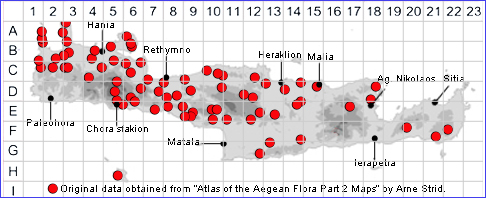
SPECIES DESCRIPTION
KNAUTIA INTEGRIFOLIA
Family and Genus:- See- DIPSACACEAE
Common Names:- None
Homotypic Synonyms:- Asterocephalus integrifolius, Knautia hybrida var.
integrifolia, Knautia integrifolia var. typica, Scabiosa integrifolia, Succisa
integrifolia, Thlasidia integrifolia, Trichera integrifolia. Tricheranthes
integrifolia.
Meaning:- Knautia (L) For Christian (Christoph) Knaut (1654-1716), German
botanist and author of Methodus plantarum genuina.
Integrifolia (L) With entire leaves.
General description:- Annual.
Stems:-
1) 20-80 cm., hirsute below, subhirsute to subglabrous above.
Leaves:-
1) Peduncles, usually eglandular.
a) basal leaves, in a rosette, dentate or crenate, glabrous or hirsute, undivided or
lyrate-pinnate with obovate or lanceolate, obtuse lobes, petiolate.
b) upper, linear to lanceolate, more or less amplexicaul.
Flowers:-
1) Capitula, hermaphrodite, c. 3 cm in diam, with 30-40 florets.
2) Female capitula, c. 1·5 cm in diam, with 20-30 florets.
3) Involucre, patelliform.
4) Bracts, in 2-3 rows, ovate at base, lanceolate-acuminate, with 3-5(-7)
inconspicuous veins, greyish velutinous, ciliate-hirsute, usually eglandular.
5) Calyx, cupuliform, 12- to 24-dentate, rarely with some teeth awned.
6) Corolla, violet:
a) marginal corollas, with outer median lobe somewhat wider than the lateral.
b) tube, c. 3-5 mm.
Fruit:-
1) With equal involucel-teeth, or those on 2 angles much longer and distinctly 2-
horned.
Habitat:- Coastal habitats, gorges, open dry shrubby vegetation, field margins,
grassy meadows, open wood- land. 0-1300 m.
Distribution:- Common throughout mainland Greece, Peloponnisos and Ionian
Islands. - widespread in the Mediterranean. Widespread across Crete, but more so
in the central and western areas.
Flowering time:- Late Mar to June.
Photos by:- Steve Lenton
